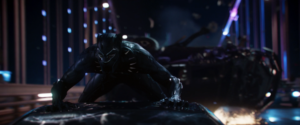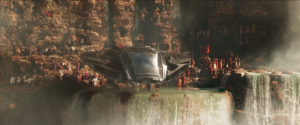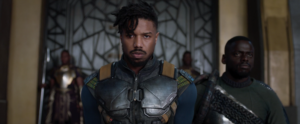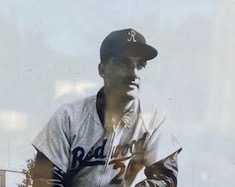Ever since the dawn of the Marvel Cinematic Universe in 2010 with Jon Favreau’s “Iron Man,” the franchise has become known for revolutionizing the way that superhero movies are made, creating an era of superhero films that will likely remain timeless. Although some movies in this universe, such as “Thor: Ragnarok” and “Iron Man 2,” fell far below the bar, Marvel remains a heavy hitter in the superhero field, pumping out yearly movies that only seem to be getting better. “Black Panther” takes the bar set by its predecessors and doesn’t simply cross it, or even jump over it. Rather, this film shatters the bar and brings it up to a height that nobody ever thought possible through its characters, music, and cinematography.
In the film, T’Challa (Chadwick Boseman) returns to his home city of Wakanda to take his recently deceased father’s place on the throne and become the next Black Panther, the defender of Wakanda with a suit made of the super metal vibranium. However, Eric Killmonger (Michael B. Jordan), a retired Black-Ops soldier, comes to Wakanda to challenge T’Challa for the throne. T’Challa is forced to rally his people and defend the throne, and the fate of Wakanda.

This is not the first superhero film with a primarily African-American cast, “Meteor Man” was released in 1993 with an African-American protagonist and cast, followed by films such as “Blinkman” (1994), “Steel” (1997), “Spawn” (1997), and the “Blade” trilogy (1998-2004). What sets “Black Panther” apart is that it portrays the future for African-American culture in a positively powerful light, something that films and TV shows today rarely do. This is called “Afrofuturism,” and it is something that goes overlooked in the majority of TV entertainment. Afrofuturism focuses on the intertwining of the future and technology with African and African-American culture, depicting a future that is both technologically advanced and but still proudly and unapologetically represents Black culture. “Black Panther” not only dives head first into Afrofuturism, it also opens the gates wide for science-fiction films to follow suit.
What sets the plot of “Black Panther” apart from its predecessor superhero films is the fact that instead of forcing Killmonger into a box of pure evil and malice, director Ryan Coogler shows that there is validity to Killmonger’s perspective. Killmonger grew up in a bad part of Oakland, and wants Wakanda to release their supply of the supermetal vibranium to the world so that African American people will have the ability to boost their status in society. He also wants to avenge his father, who was trying to accomplish the same. This tears viewers between the choice of protecting the sanctity of Wakanda and sympathizing with the man who just wants to free his race from a never ending cycle of poverty.

This element of uncertainty is what forces “Black Panther” out of the category of entertainment or just a flashy flick into an epic. It is a story that is as entertaining as it is thought-provoking, keeping the audience glued to the screen and constantly reflecting on their own morals as the characters battle for power.
“Black Panther” is Oakland native Ryan Coogler’s third major film, with Michael B Jordan taking a lead role in all three. Coogler’s first film was “Fruitvale Station,” a masterpiece about the tragic murder of Oscar Grant III on BART by police in 2009. Next, he moved on to make Creed, an unofficial sequel to the “Rocky” films. In all three of his films, Coogler’s greatest strength is his ability to blur the line between a “good guy” and a “bad guy.” He creates characters that the audience finds themselves both rooting for and hating, who one second they hope to see defeated and the next see the world through their eyes. In “Fruitvale Station,” Coogler brought us Oscar Grant III, in “Creed,” Apollo Creed and in “Black Panther,” Erik Killmonger.
The plot is reinforced by stunning visuals as well. From the intricate costume design of the Black Panther suits, to fly-overs of the futuristic city of Wakanda imbedded in a lush green jungle, to a smoky underground casino in Asia with bills fluttering through the air in slow motion, each scene is composed like an individual work of art, leaving the viewer remembering not only the action, but how breathtaking the scene was as well.
“Black Panther The Album” was released prior to the film, and similarly to how the film blasted expectations, hip-hop powerhouse Kendrick Lamar lead a very diverse 14-track album with names such as SZA, The Weeknd, 2 Chainz, ScHoolboy Q, Khalid, Vince Staples, Travis Scott, and many other hip-hop and R&B giants. “King’s Dead” by Kendrick Lamar, Jay Rock, Future, and James Blake instantly went viral on Youtube for its music video with intense zooms, rooftop and treetop dance moves, and Kendrick standing in the middle of the street with cars spinning in circles around him. “X” by ScHoolboy Q, 2 Chainz, and Saudi delivers a moody bass and haunting pluck accompanied by a catchy hook from Kendrick Lamar. “The Ways” by Khalid and Swae Lee is an uptempo emotionally driven R&B track with fast rolling high hats and floating melodies carrying the track and keeping the pace up. All of the tracks on this album are tied together with contributions to the bridge or chorus by Kendrick Lamar, with his harmonies and

many voices rising and falling in each piece. Even though each track may not be similar to the one before it, Kendrick’s omnipresence ties the album together.
The one disappointing part of this seemingly perfect album-movie combination was the lack of integration between the two. With Kendrick’s voice echoing at the beginning of “Paramedic!” by SOB X BRE, I expected the songs to be integrated into the movie, emphasizing the dark and aggressive atmosphere that the preview had shown. However, almost none of the tracks were featured in the film, and some of the ones that were had only the instrumentals or only a couple of seconds included. This was a huge loss of potential. It would have been much better for the film that was already getting attention for breaking the norm to integrate the album that got everyone excited for the movie and featured some of the best artists in the rap and R&B scene right now. Instead, they opted for the same overused, dramatic orchestral scores that every Marvel movie seems to recycle. While the soundtrack was beautiful, it draws the question of why they opted not to use the wildly successful album that was tied in with the film.
This movie and soundtrack has brought afrofuturism screaming into the mainstream, and is not only being received positively by the African-American community, but by the rest of the world as well. Whether it be through Michael B Jordan replacing a retainer that an 18 year old girl bit through during his shirtless scene or all of the “Wakanda forever” memes that followed, this movie has just made history.
















